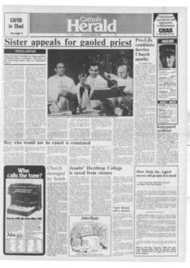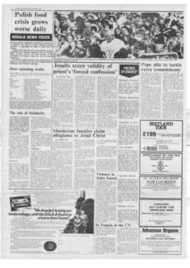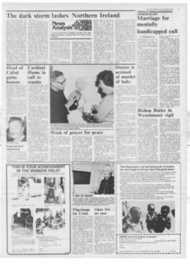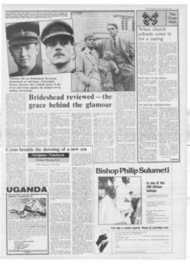Page 9, 16th October 1981
Page 9

Report an error
Noticed an error on this page?If you've noticed an error in this article please click here to report it.
Tags
Share
Related articles
Problems Of Designing Papal Arms
Scandinavian Post
Heraldry In The Church
Variations On An Enigma
A Call To Heraldic Arms
ARCHBISHOP Bruno Heim. the Swissborn Apostolic Delegate to Great Britain
is not just the foremost authority on the venerable art of heraldry in the Catholic Church, but also the man who draws up the coats of arms for new Popes.
It is a job which has to be done with speed, as the arms of a newly elected Pope must be available for use within weeks, and one in which there is ample scope for blunders. A row blew up over the shield of Pope John Paul II, the third bearer of papal arms in the year of the three Popes.
Heralds around the world (and they are a very' touchy lot) complained that the gold letter M on the shield offended against the rules of heraldry. For the first time. the inside story has come out in a new book by Archbishop Heim, a much enlarged edition of his Heraldry in the Catholic Church*.
It is surprising enough that this expensive. if handsome, volume should have sold at all, given the esoteric reputation of its subject. But its publisher, Peter Bander van Duren was delighted to find it selling out. and the opportunity turning up to issue an edition including an explanation of the controversy that the Apostolic Delegate unwillingly found himself the centre of, after the Pope's election.
According to Mr van Duren, the new Pope was under a lot of pressure from the Curia to remove the M from his coat of _arms. It had featured on his shield as Bishop of Cracow, and now that he was Bishop of Rome and Pope. they wanted a complete break.
What they did not realise was that Pope John Paul, who since then has become a good amateur expert on heraldry, was a man of single-minded determination, even over a thing like this. Five symbols were suggested to replace the letter, which the Pope had first adopted from his strong devotion to Our Lady. They represented the Morning Star. Lily. Mystical Rose,Queen of Heaven. the Tower of Ivory.
The Pope seriously studied the examples and made it clear that he genuinely liked them. In the end he reverted to his original symbol, the letter M. because he felt his beloved flock in Cracow might feel deserted if he changed the arms that had become well known during his time as their archbishop.
Archbishop Heim takes up the story, in defence of the arms he finally drew up for the Pope: "It is true that letters are not proper heraldic charges, and the expert, given the choice would prefer symbols to letters.'"
"Nevertheless those who think the Pope was ill-advised when he chose his shield. know very little of Polish heraldry ... There is frequent inclusion of letters. These are charges called housemarks. It is interesting to note how often one comes across the letter M."
"These signs were often carved on doorframes. arches. panels. and on tools of every kind to indicate ownership. In the HerbarzCompendium of W. W. Kojalowicza. S. J., 210 out of 388 coats represented (i.e. 54 per cent) arc of this kind. Strangely enough this
same kind of housemark used as heraldic charges occur also frequently in Switzerland."
In Britain, Archbishop Heim has been turning his hobby of amorial painting into an ecumenical exercise. The first coat of arms of an Anglican priest drawn by Archbishop Heim was that of Dr Edward Carpenter. the Dean of Westminster. It involved a new ruling by the official authority on heraldic matters, the Hereditary Earl Marshal, the Duke of Norfolk, a Catholic.
This followed concern over the use of ecclesiastical hats by Anglicans in the manner of Catholic prelates. The newsletter of the Heraldry Society put it like this: For some decades certain clergy of the Anglican Communion have used ecclesiastical hats in place of helms and crests in much the same way as is done in the Roman Church ... The trouble has been that this practice, having the blessing of neither the Church nor the heraldic establishment, has been very much a D.I.Y. exercise."
Heraldry tends to march calmly on in a stately unconcern for those ignorant of its ways. Catholic clergy themselves have fallen foul of the law on the display of arms. They have blithely displayed arms of their own invention or which have never been granted by the college of Arms,the only body capable of making legal authorisation of arms in this country.
The coat of arms of Archbishop Michael Bowen of Southwark is the most ancient true armorial bearing of a Catholic bishop in England. It was granted to his family in 1729. As an archbishop he has been personally granted the 'achievement of dignity' of a double traversed cross and a hat with ten tassels on each side. That is how his shield is shown in Archbishop Heim's heraldic painting of it.
At the other end of the scale of propriety. the Apostolic Delegate has had to deal with a no doubt well-intentioned enquiry concerning the gift of a silver-gilt skittle or bowlingpin which some Irish pilgrims wanted to give the Pope. Though pictures have appeared of the Pope playing the Italian bocce. he seemed to have no knowledge or expertise in skittles, whether crested or not.
An example of obscurity piled on obscurity which the Archbishop tackles at the end of his scholarly work is the question of heraldry' in the uniate churches of various eastern rites. Notable among these are the Armenian. Byzantine, Chaldean, Coptic. Maronite and Syrian rites. For heraldic art this has an essential significance. In the Byzantine rite, for example.
including the Greek, Russian. Melkite, Ruthentan, Yugoslav, Bulgarian and Rumanian churches, the bishop's headgear is not the metre but, for _pontifical Mass. a princely crown. not of precious metal. but of stiff material adorned with gold, brocade and precious stones. or embroidered with flowers, crosses or icons. Oriental arms have been wrongly displayed in the past. Archbishop Heim cuts through the tangle of confusion.
* Van Duren. £25.
blog comments powered by Disqus













